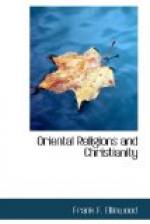Any fair comparison of the two histories should confine itself to the writings which are regarded as canonical respectively, and whose dates can be fixed. No more importance should be attached to the later Buddhist legends than to the “Apocryphal Gospels,” or to the absurd “Christian Legends” which appeared in the middle ages. The Buddhist Canon was adopted by the Council of Patna 242 B.C. The legends which are generally compared with the canonical story of Christ are not included in that Canon, or at most very few of them. They are drawn from certain poetical books written much later, and holding about the same relation to the Buddhist Canon that the “Paradise Lost” and “Paradise Regained” of Milton bear to the scriptures of the Old and New Testaments. Who would think of quoting “Paradise Lost” in any sober comparison of Biblical truth with the teachings of other religions?[94]
Even the canonical literature, that which is supposed to contain the true history and teachings of Buddha, is far from authoritative, owing to the acknowledged habit—acknowledged even by the author of the “Dhammapada” of adding commentaries, notes, etc., to original teachings. Not only was this common among Buddhist writers, but even more surprising liberties were taken with the narrative. For example: The legend describing Buddha’s leave-taking of his harem is clearly borrowed from an earlier story of Yasa, a wealthy young householder of Benares, who, becoming disgusted with his harem, left his sleeping dancing girls and fled to the Buddha for instruction. Davids and Oldenberg, in translating this legend from the “Mahavagga,” say in a note, “A well-known incident in the life of Buddha has evidently been shaped after the model of this story;” and they declare that “nowhere in the ‘Pali Pitakas’ is this scene of Buddha’s leave-taking mentioned.”
As another evidence of the way in which fact and fiction have been mixed and manipulated for a purpose, one of the legends, which has often been presented as a parallel to the story of Christ, represents the Buddha as repelling the temptation of Mara by quoting texts of “scripture,” and the scripture referred to was the “Dhammapada.” But the “Dhammapada” was compiled hundreds of years after Buddha’s death. Besides, there were no “scriptures” of any kind in his day, for nothing was written till two or three centuries later; and worse still, Buddha is made to quote his own subsequent teachings; for the “Dhammapada” claims to consist of the sacred words of the “enlightened one.” Most of the legends of Buddhism were wholly written after the beginning of the Christian era, and it cannot be shown that any were written in their present form until two or three centuries of that era had elapsed. T.W. Rhys Davids says of the “Lalita Vistara” which contains a very large proportion of them, and one form of which is said to have been translated into Chinese in the first century A.D., “that




